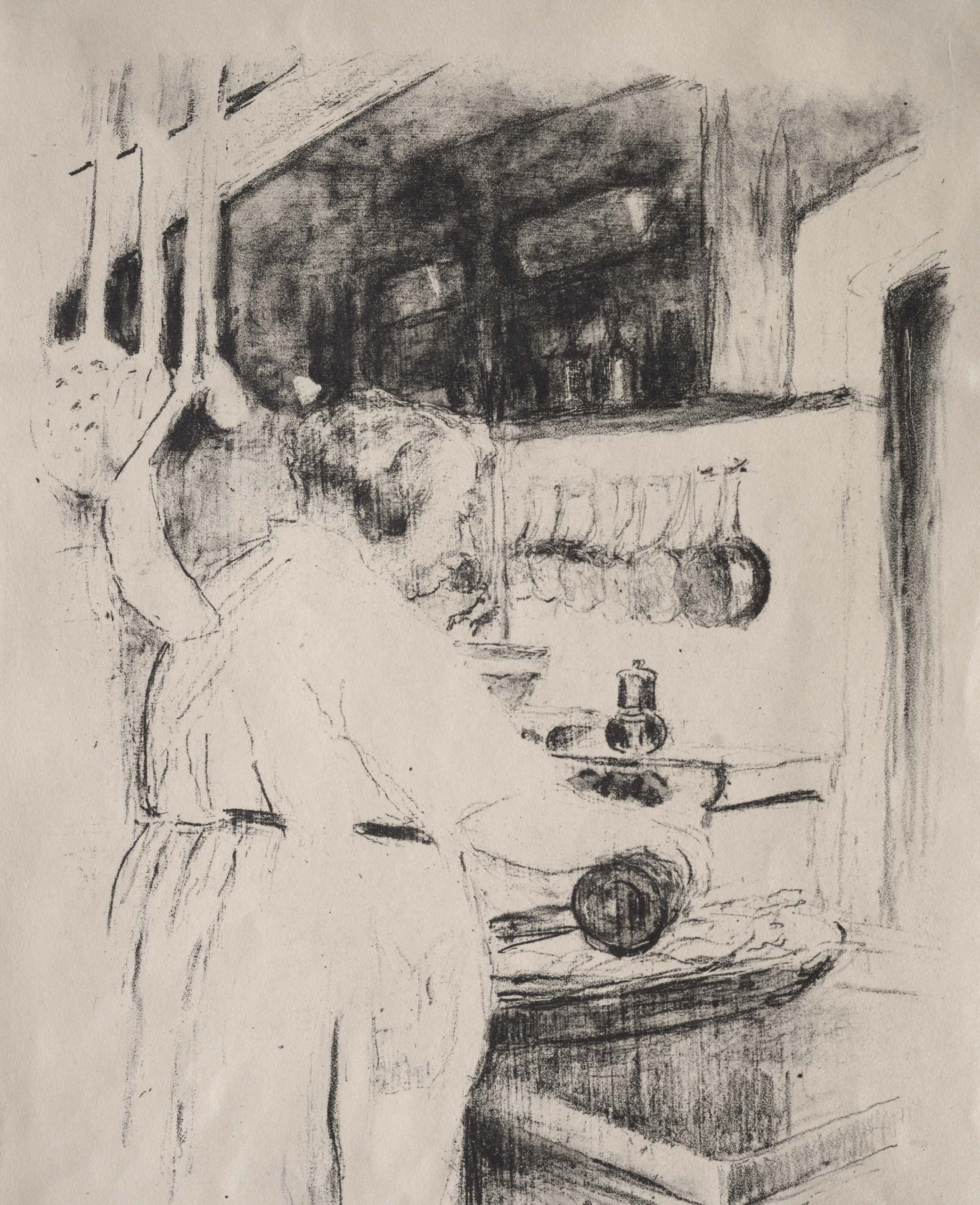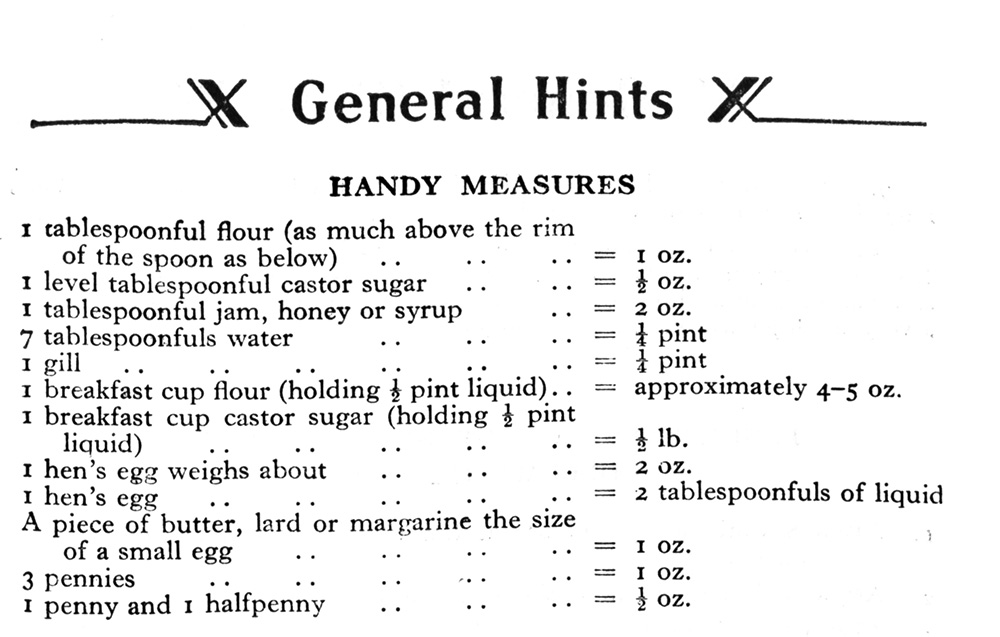
Cooking: The Cook, by Edouard Vuillard, 1934. The Cleveland Museum of Art.
In evidence given to Parliament’s 1862 Select Committee on Weights and Measures, a Mr. Greenall remarked on the extraordinary number of different historical weights and measures in use at that time across Britain, listing the grain, dram, drop, ounce, pound, stone, score, ton; the wool measure of clove, tod, wey, pack, sack or last; the straw measure of truss and load; the draper’s measure of inch, nail, ell and yard; the long measure and land measure of line, size, hand, foot, palm, span, pace, step, link, knot, rood, hide, rod, pole or perch, fall, chain, mile and league; plus various other scales of measurement including the strike, peck, pot, gill, pint, quart, tierce, boll, coomb, pipe, butt, tun, and score. This impressive array of customary measurements not only shows the plethora of competing and coexisting weights and measures in Britain but also reveals the innate human desire to create order. Every sector of industry saw fit to develop its own method to assess weight, length, volume, or area, attesting to the importance of measurement in trade and commerce. What Mr. Greenall’s list also reveals is that by the mid-nineteenth century more and more voices were advocating that we call time on the myriad measures. Those bastions of Victorian life, science, industry, and rational thought, demanded a consolidation of measurements. But what has made some persist to this day, while others have fallen from use? Claire Cock-Starkey’s The Curious History of Weights & Measures tells their story.
Stone
The beauty of the stone as a unit of measure was that any locality could identify a rock of decent dimensions and adopt it as the local stone in weight. Since antiquity a stone had been used as a measure, although it did not need to be assigned an actual value. Instead, any good-sized stone could be used as a counterbalance to ensure that commodities could be equally split, meaning that this system could be used in societies where arithmetic had yet to develop. Across northern Europe stones were used in this way to measure dry goods, with the earliest examples dating back to the Roman Empire. (The pound of weight also originates in the Roman Empire, where it was known as libra pondo. It derived from the Latin word libra, which like the sign of the zodiac meant a balance or scale but was also used to refer to a measure—pound by weight. This Latin word is the reason why pounds are abbreviated as lbs.—a shortening of the word libra. There was little standardization, and the weight of stones could vary from country to country, region to region and even village to village, ranging from as little as 4 lbs. all the way up to 40 lbs. It was not only the location which affected the weight of the stone; sometimes the weight varied depending on the goods being weighed. For example, an English statute from around 1300 set a London stone at 12.5 lbs.; however, a stone for weighing lead was said to be 12 lbs., while a stone for measuring beeswax, sugar, pepper, cumin, almonds and alum was 8 lbs., and the stone for weighing glass was 5 lbs. The inconsistent and archaic use of stones continued in Britain for some time. An example of this can be seen in the system used by British butchers: the stone used for measuring the weight of livestock was generally accepted to be 14 lbs. but the resultant meat was measured with an 8 lbs. stone. It is thought that this was because butchers would return the dressed meat from an animal carcass back to the farmer stone for stone—the weight difference meant that the butcher could keep the blood, offal and hide as payment. Butchers at Smithfield Meat Market in London continued to employ the 8 lbs. stone right up until World War II.
As the wool trade became increasingly important to Britain the wool stone was in 1350 set by statute at 14 lbs., although different stones were still permitted for use for other commodities. A variety of different stones depending on the commodity being traded continued to coexist for hundreds of years until 1835, when it was decided that an overarching imperial stone should be codified. Perhaps because wool had been such a key commodity in England the wool stone of 14 lbs. was selected to become the imperial stone. Scotland largely used a stone based on 16 Scottish pounds until 1824, when an act made all weights and measures uniform across the United Kingdom. Despite the introduction of the imperial stone, a parliamentary committee reported in 1862 on the confusion of the current state of weights and measures in Britain, stating that fourteen different stone weights were currently in use. By the 1970s Britain’s increasingly close trading relationship with the European Union meant that most businesses were keen for Britain to adopt metric measures. The stone fell out of favor for trade, although it was still permitted to be used as a “supplementary unit,” which meant it could be used as long as metric measures were given alongside it. But by 1985 the stone was officially removed from the list of measurements that could be legally used for trade purposes. Despite metrification, many Britons continue to give their weight, or the weight of their livestock, in stones and pounds. An interesting side note is that, although the stone was not greatly used in America, in 1790 Thomas Jefferson suggested a new decimal system of coinage, weights and measures. His decimal currency was adopted, but his idea to introduce an American stone of 10 lbs. (with each pound weighing ten ounces) was rejected.
Smidgen, pinch, dollop, dash, and drop
These words, used casually in a recipe, fill novice cooks with fear. Most people recognize that they refer to a small amount of something, but just how small is left open to interpretation. When recipes first began to be written down they were recorded in the vernacular, rather than with a rigid list of exact measurements, meaning that many recipes are peppered with these inexact terms. Some delightful examples of imprecise cooking measurements are seen in Martha Lloyd’s Household Book, written in the eighteenth century and recently published in facsimile: “Fricassee Turnips: Cut your Turnips in dice, when boiled and put a little cream to them, Thickened with flour & add a little lump of sugar to your taste.” As recipe-writing has become more standardized (and weighing scales more reliable) most weights and measures are given in official measures. However, for seasoning we have kept many of the traditional words, such as “smidgen,” “pinch,” and “dash,” which I like to think gives the cook room to adjust the amount to their personal taste.
Smidgen likely comes from the Scottish word smitch, which also means a very small amount. (A side note: it is interesting that many words for small quantities start with “sm”—including the word “small” itself; for example, “smithereen,” “smattering,” “smudge.”) Smidgen is generally used to refer to an almost trace amount, a few grains or a tiny sliver. A pinch is more obvious as it relates to how much you can hold between index finger and thumb. It perfectly encapsulates the physical act of taking a small amount of seasoning and throwing it into the pan. Dash and drop both tend to relate to liquid, and again they conjure up a mental image of the correct amount—a single drop of liquid falling from a spout or the verve of a sudden shake of a bottle which results in a larger dash. Dollop means a lump or clump and comes from dallop, the East Anglian dialect word meaning a “tuft of grass.” Dollop generally refers to something viscous, such as cream, mayonnaise, or yogurt. It has a glorious onomatopoeic character which readily conjures up the sound of a blob of cream plopping luxuriously from spoon to plate.
To assist novice cooks it seems some American food writers have begun giving exact measurements (as fractions of teaspoons) to the traditionally inexact terms. A dash is said to be 1/8 of a teaspoon, a pinch 1/16 of a teaspoon, a smidgen 1/32 of a teaspoon, and a drop 1/64 of a teaspoon. You can now even purchase a set of measuring spoons for these tiny amounts. I have noted them here for posterity, but it is perhaps best to keep them undefined. I see them as the element of the recipe that grants me license to add as much or as little as I see fit, so my dash might be rather sparing when it is vinegar but tends to get rather more expansive when it is wine.

Reprinted with permission from The Curious History of Weights & Measures by Claire Cock-Starkey, published by Bodleian Library Publishing. © 2023 by Claire Cock-Starkey. All rights reserved.
